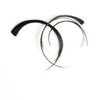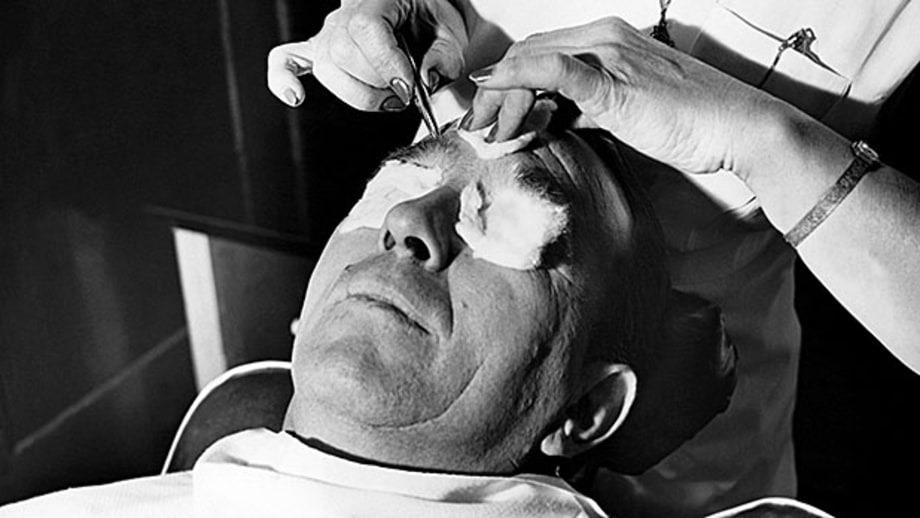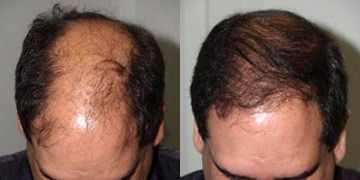|
Maybe you think no one notices the bald spot where you over zealously trimmed your beard this morning. Or cares that you used enough hair gel to seal the bricks in your fireplace. But someone does — and he'd like to tell you about it. Meet your long-suffering barber: The man who bears the brunt of your amateur-hour grooming aspirations. In fact, your barber has seen more grooming bloopers and styling gaffes in his years of practice than you will (hopefully) encounter in your lifetime. "As a third generation barber who has been cutting hair for over 20 years, I've pretty much seen everything," Greg Zorian, owner of Gregory's Barber Shop in Albany, NY, says. It only makes sense then, that if you want to know what not to do to your hair, he's the man to ask. “The short answer is, if you're not sure whether you should do something to your hair, you probably shouldn't," he adds. Here, seven cardinal sins of grooming ye shall not commit.
The Dry Shave You overslept. Your meeting was bumped up to 7:30 a.m. You are in a hurry. None of these unfortunate occurrences excuses you from attempting to remove your facial hair with nary a shave gel, foam can or, for God's sake, plain old water in sight. What happens to your skin when you dry shave? "Oh, it's bad," Alexia Saras, barber manager at Fellow Barber in Manhattan, says. "Dry shaving causes ingrown hairs, rashes, and skin burns. You really don't want to go there." At bare minimum, you need a pre-shave oil, she says, to soften the skin and help the blade glide smoother over the surface. "Then, follow the oil with light shave cream that you apply with or without a brush." The Goop du Jour The hair on your head weighs, at best, half an ounce. The pomade in that jar? Five to ten times as much. So simple math would suggest that your hair can't hold much product before it looks like crap. "You’d be surprised the guys who just dip their hand in the jar and put it right on their head," Saras says. "The specific amount you use is going to vary depending on the product and your hair type, but as a rule, always start with less than you think you need. You can add, but you can't subtract once it's in your hair." Also, work up the product in your hands first until it's smooth, so there are no big chunks going right into your hair. If you're still unsure, ask your barber to demonstrate. "I always show my clients how to apply it," Saras says. The Self Trim In most towns, you can get a barber to cut your hair for about 20 bucks. That's a beer and a burger at your local pub, or a few cups of coffee at your overpriced espresso joint. So why must you insist on grabbing your kitchen scissors, or beard trimmer, and attempting surgery yourself? "Proceed at your own risk," cautions Charles McCoy, master barber at Kiehl's Barber Shop in New York. "You may find yourself with patches left over and a poorly finished head of hair." What’s that? You're just trying to even out your neckline? "I have a friend who sees a little hair on the back of his neck and grabs a razor to 'fix' things," Zorian adds. "From the front, it looks okay, but what he can't see is the little tail he leaves in the back from the spot he missed." Worse, Zorian says, are the guys who turn their razors upside down and shave the back of their neck up into their hairline. "I'll go to trim it and there is a huge hold underneath the hairline from running the razor too high." At better approach: Pop into your barber shop for a trim every four to six weeks — unless you're going for a buzz cut, in which case "it's fine to do solo, as long as you understand the fundamentals of proper hair care," McCoy says. In other words, see a pro. The Helmet Head We get why you want your hair to hold its style. We don't get freezing your hair into a permanent state of hardness, so that your barber needs WD40 to loosen it up before your cut. "There will always be guys who use half a bottle of gel and their hair looks like it won't move for the next year," Zorian says. "You're not going to talk them out of it." For everyone else, a dollop the size of a nickel is plenty to start. "Rub it down into the roots, comb it through the hair, and let it dry," he advises. If you still want more hold after that, add a finishing paste to dry hair, not more gel, which will result in something akin to helmet-head. Another tip: Using a gel on overly-wet hair won't work, Zorian says, because most gels are water-based, meaning they dissolve in water and will lose their potency. Shower, towel dry, then apply. The Comb-Over Everybody knows the guy who does the comb-over. You laugh about it, and wonder if he thinks he's fooling anyone. Then one day, you wake up and discover your hair is thinning. And in the midst of your premature midlife crisis, somehow you become that guy. "I have many clients in this situation," Saras says. If you find yourself caught between a comb-over and a bald spot, "covering it up is never a great option." Better move: Get your hair trimmed close in the area that's thinning (usually on top), and leave it longer on the sides — it will look fuller, Saras explains. The other choice: Shave it all off. Because at the end of the day, if you are going bald, all the clever styling and trimming in the world isn't going to disguise your predicament for long. The only thing that will: A clean shave that leaves people guessing what your hair might look like, if you had any. The Patchy Beard It's not soul patches, but that hole in your beard that drives barbers crazy. "Most beards don't grow in perfectly even — some areas of your face will grow more hair than others," Saras says. You can try to spread the wealth of hair that you do have by using beard oil or mustache wax to smooth out curly areas, which can help cover thin patches, but ultimately, "this is a job for a professional." What your barber can do: "If the bald patch is under your chin, I will fade the beard down to that spot, so it looks natural," she says. "If it's higher up or on your cheek, we can move the beard line below the spot." The better overall care you take of your beard, the less likely you are to find thin patches. "Apply a moisturizer or beard oil every evening before bed," McCoy says. "It will keep your beard and the skin underneath in great shape." The Brow Beater Being aware of your unibrow is half the battle. (Barbers say many men sporting the single hairy strip do so in blissful oblivion — it's their significant other that sends them in for help). Ridding yourself of the caveman look takes practice. "If a client has just a few longer hairs, I will use a scissor-over-comb approach to even them out," Zorian says, who adds that he doesn't think eyebrows should look too perfect, but thinks waxing is right for guys who want shape. "Waxing is effective if you have a high pain threshold," McCoy agrees. For a more natural finish, he uses tweezers — "it might sting a bit but it's better than shaving, which can leave dark follicle marks between the brows, and hair can regrow with a vengeance."
0 Comments
7/31/2016 0 Comments Hair Transplants: What to ExpectReviewed by Michael W. Smith, MD
Like good health and youth, most of us take our locks for granted -- that is, until they're gone. For many people, a hair transplant can help bring back what looks like a full -- or at least a fuller -- head of hair. If thinning up top or going bald really bothers you, the procedure can be one way to feel more confident about your looks. But first talk with your doctor about what you can expect during and after the surgery. What Is a Hair Transplant? It's a type of surgery that moves hair you already have to fill an area with thin or no hair. Doctors have been doing these transplants in the U.S. since the 1950s, but techniques have changed a lot in recent years. You usually have the procedure in the doctor's office. First, the surgeon cleans your scalp and injects medicine to numb the back of your head. Your doctor will choose one of two methods for the transplant: follicular unit strip surgery (FUSS) or follicular unit extraction (FUE). With FUSS, the surgeon removes a 6- to 10-inch strip of skin from the back of your head. He sets it aside and sews the scalp closed. This area is immediately hidden by the hair around it. Next, the surgeon's team divides the strip of removed scalp into 500 to 2,000 tiny grafts, each with an individual hair or just a few hairs. The number and type of graft you get depends on your hair type, quality, color and the size of the area where you’re getting the transplant. If you’re getting the FUE procedure, the surgeon’s team will shave the back of your scalp. Then, the doctor will remove hair follicles one by one from there. The area heals with small dots, which your existing hair will cover. After that point, both procedures are the same. After he prepares the grafts, the surgeon cleans and numbs the area where the hair will go, creates holes or slits with a scalpel or needle, and delicately places each graft in one of the holes. He’ll probably get help from other team members to plant the grafts, too. Depending on the size of the transplant you’re getting, the process will take about 4 to 8 hours. You might need another procedure later on if you continue to lose hair or decide you want thicker hair. Expectations and Recovery After the surgery, your scalp may be very tender. You may need to take pain medications for several days. Your surgeon will have you wear bandages over your scalp for at least a day or two. He may also prescribe an antibiotic or an anti-inflammatory drug for you to take for several days. Most people are able to return to work 2 to 5 days after the operation. Within 2 to 3 weeks after surgery, the transplanted hair will fall out, but you should start to notice new growth within a few months. Most people will see 60% of new hair growth after 6 to 9 months. Some surgeons prescribe the hair-growing drug minoxidil (Rogaine) to improve hair growth after transplantation, but it’s not clear how well it works. Risks and Costs of Treatment The price of a hair transplant will depend largely on the amount of hair you’re moving, but it generally ranges from $4,000 to $15,000. Most insurance plans don’t cover it. As with any kind of surgery, transplants have some risks, including bleeding and infection. There’s also the chance for scarring and unnatural-looking new hair growth. Around the time new locks start to grow, some people have inflammation or an infection of the hair follicles, called folliculitis. Antibiotics and compresses can relieve the problem. It’s also possible to suddenly lose some of the original hair in the area where you got the new strands, called shock loss. But most of the time, it’s not permanent. Talk with your doctor about these risks and how much improvement you’re likely to get from the surgery. He can help you decide if it's a good option for you. Here is a Good Site for Pics, Q&A, Costs https://www.realself.com/Hair-transplant-surgery/reviews by Sania Claus Demina
Our hair is probably never as exposed to sun, heat, dry winds and sea water more than during Summer. But don't stress, there are a few things you can do to avoid frizz and dryness, while keeping your hair fresh the whole season. Here are 6 easy steps to prep your hair for the Summer. 1. GET A HAIRCUT. Start off Summer with a fresh look. 2. MOISTURISE. Invest in a really good moisturising hair treatment, and make it a habit to use it at least twice a week. 3. FRESH BRUSH. Don't forget to wash your hair brush with a bit of shampoo. Maybe even time to get yourself a new one? 4. STYLISH PROTECTION. Get a hat! It's the best way to avoid burning your head while staying sane in the sun, and its obviously very stylish. 5. UV PROTECTION. Your hair needs UV protection. Take an extra look at your products and be sure at least some of them contain some UV protection, whether it be your styling cream or shampoo. 6. HAIR OIL. The best way to avoid dry hair and frizz is to treat your hair with oils. Apply from the middle of your hair down. 7/23/2016 0 Comments The Surprising History of Shampoo4000 BC
Pampering through hairstyling and the use of bathhouses emerges among the rich in ancient Mesopotamia. 3000 BC The concept of cleanliness becomes more widespread, and helps differentiate between people and animals. 500 BC Purity of clean water and personal hygiene evolve during the Classical Greek Period. 400s According to diplomat Sidonius Apollinarus, German Burgundians "spread rancid butter in their hair" which we really would not recommend. 1500s Early shampoos were made in India from soapberries, herbs & flowers. This concept came to Britain via traders, and hair stylists swapped soapberries for boiled soap. 1700s The word shampoo (from Hindi word champo, meaning to press or massage) enters the English language. 1800s Shampoo becomes available for home use in Europe, and monthly hair washing becomes the norm. Early 1900s A New York Times article proclaims that hair should be washed as often as every two weeks. Hans Schwarzkopf develops a popular water-soluble powder shampoo in Berlin, but it dulled hair. Sorry Hans. 1920s Hans Schwarzkopf introduces one of the world's premiere liquid shampoos - thank goodness! 1930s Dr. John Breck develops the first pH balanced shampoos for dry, oily or normal hair, only available in New England. Drene introduces the first shampoo using synthetic surfactants (sulfates) instead of soap. The first non-alkaline shampoo is invented by descendant lines of the Schwarzkopf institute for hair hygiene. 1950s Johnson's launches the first baby shampoo with its "No More Tears" formula. 1970s Ads featuring bombshells Farrah Fawcett and Christie Brinkley push washing hair several times a week, claiming that not doing so is unhealthy. Psssssst releases first dry shampoo, an aerosol cleaner containing a starch derivative. It soaked up oil, but still left hair feeling unclean. 1987 The first 2-in-1 conditioning shampoo is introduced. Unfortunately, it relies on silicones, which cause build-up, leading to overwashing and damage. Early 2000s Mild, no-lather cleansing conditioners are made mainstream. 2009 Shampoos with healthy hair molecules that keeps hair cleaner longer and by repelling dirt and oil are introduced. 2015 Dry shampoos that absorb oil, sweat and odors and actually cleans the hair are introduced and take off. Check out this neat chart |
Hair by BrianMy name is Brian and I help people confidently take on the world. CategoriesAll Advice Announcement Awards Balayage Barbering Beach Waves Beauty News Book Now Brazilian Treatment Clients Cool Facts COVID 19 Health COVID 19 Update Curlies EGift Card Films Follically Challenged Gossip Grooming Hair Care Haircolor Haircut Hair Facts Hair History Hair Loss Hair Styling Hair Tips Hair Tools Health Health And Safety Healthy Hair Highlights Holidays Humor Mens Hair Men's Long Hair Newsletter Ombre Policies Procedures Press Release Previous Blog Privacy Policy Product Knowledge Product Reviews Promotions Read Your Labels Recommendations Reviews Scalp Health Science Services Smoothing Treatments Social Media Summer Hair Tips Textured Hair Thinning Hair Travel Tips Trending Wellness Womens Hair Archives
January 2025
|
|
Hey...
Your Mom Called! Book today! |
Sunday: 11am-5pm
Monday: 11am-6pm Tuesday: 10am - 6pm Wednesday: 10am - 6pm Thursday: By Appointment Friday: By Appointment Saturday: By Appointment |






 RSS Feed
RSS Feed